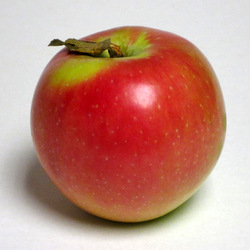Learn More About Heirloom Apples

“Surely the apple is the
noblest of fruits.”
– Henry David Thoreau
What’s the best pie apple? How do you find the best sweet and crisp eating apple? Get an understanding of the dozens of apple varieties City Market sells with the information below. For a list of all the varieties we sell with their best uses, seasonality, flavor profile, and a history of each type of apple, click here.
For a PDF version of this page, click here.
The History of Apples in America
“As American as Apple Pie,” says a common cliché, but apples are not native trees to America! Apples were among the first crops brought to North America by European settlers starting in the early 1600s.
These early settlers depended on apples – and not just as a source of fresh fruit. Many of the apple trees produced fruit that was unpleasant for fresh eating so it was used to make cider. This cider was then turned to apple cider vinegar which in turn was used for pickling vegetables. Applejack (brandy made from apple juice) was used as a preservative for other fruits.
From these first settlers, we now have an astounding diversity of apples in America with over 16,000 named varieties. There are more varieties of apples than any other crop grown in the US.
With modern agriculture, a handful of varieties have come to dominate the apple market. One apple variety – the Red Delicious – now comprises 41% of the entire American apple crop. One of our local farms, Scott Farm, in Dummerston, VT, continues to grow over 90 different kinds of apples, helping preserve these old heirloom varieties with their unique flavors, textures and names (ever eaten a D’Arcy Spice, a Duchess of Oldenburg or a Hubbardston Nonesuch apple?!).
Tips on Storing Apples
To get the most from your apples always refrigerate them. If you prefer to store apples in a bowl to perfume a room, try to eat them within a few days.
Heirloom Apples
City Market sells over 90 varieties over the course of the fall season. Each variety has a story about where it came from and what it tastes like.
While all of the heirloom varieties can be eaten fresh, some are better used for baking, drying into apple rings, or even making fresh cider. We encourage you to try the different varieties over the season and see what flavors and textures you most enjoy eating. We provide some guidance and information on the shelf signs found on each crate of heirloom apples to help inform your choice, but you can always ask a staff person in our Produce Department for a taste of the different varieties!
We also have more information about the varieties we sell and suggestions for their best uses here.
Heirloom Apple Terms
You’ll see these terms in the names of different heirloom apples we sell.
- Kernel – an apple tree grown from a seed (most apple trees are grafted)
- Pippin – a “chance” apple that sprouted from a random apple seed, or “pip”
- Russet – apples with a slightly rough greenish-brown or yellowish-brown skin referred to as “russetting”
- Seedling – an apple tree grown from a seed (synonymous with a Kernel)
Baking with Heirloom apples
Many heirloom apples shine when they are used for baking. Zeke Goodband, orchardist at Scott Farm, claims, “The better the pie apples, the less you need a heavy dose of sugar and spices.” While all varieties may be used to make an apple pie, crisp, or cake, many expert bakers recommend using a combination of varieties to balance three flavors:
- High in tannins (bitter flavors)
- High in acid (tart flavors)
- High in sugars (sweet flavors)
Hamilton Davis, a Burlington baker who has baked extensively with our collection of heirloom apples, recommends three parts tannin apples, two parts very tart apples, and one part sweet apples to make a perfectly balanced apple pie. You might try playing around with combinations of the following kinds of apples:
Good Tannic Apples:Belle de Boskoop |
Good Tart Apples:Ananas Reinette |
Good Sweet Apples:Cox’s Orange Pippin |
Based on the season and what’s available in the Co-op, mix and match these varieties in an apple pie. Find our recipe online at www.citymarket.coop/recipe/worlds-best-apple-pie-filling.
Applesauce
Applesauce is incredibly easy to make at home. Use any apple variety or combination of varieties you like – apples with red skins will make pink applesauce while apples with green or yellow skins (or peeled apples) will make yellow or tan applesauce. Applesauce will keep in the fridge for several days. Freeze any leftover applesauce and it will keep for months! Find a recipe online at www.citymarket.coop/recipe/applesauce.
Did you know?
- Apples are a member of the rose family.
- The earliest archeological evidence of apples as a food crop dates back to 6500 B.C.
- The old saying "an apple a day, keeps the doctor away" comes from an old English adage, "To eat an apple before going to bed, will make the doctor beg his bread."
- Apples are fat, sodium, and cholesterol free.
- Apple trees take four to five years to produce their first fruit.
- 25 percent of an apple's volume is air. That is why they float.
- Keep cut apples from turning brown by dipping them in a solution of 1 part citrus juice and 3 parts water.
- Apples give off gases that will speed up the ripening of peaches, plums, pears, bananas and kiwis.
Our Local Apple Orchards
- Champlain Orchards, Shoreham
- Dwight Miller and Son Orchards, East Dummerston
- Scott Farm, Dummerston
- Shelburne Orchards, Shelburne
- UVM Horticulture Farm, South Burlington
View Heirloom Apples in a larger map